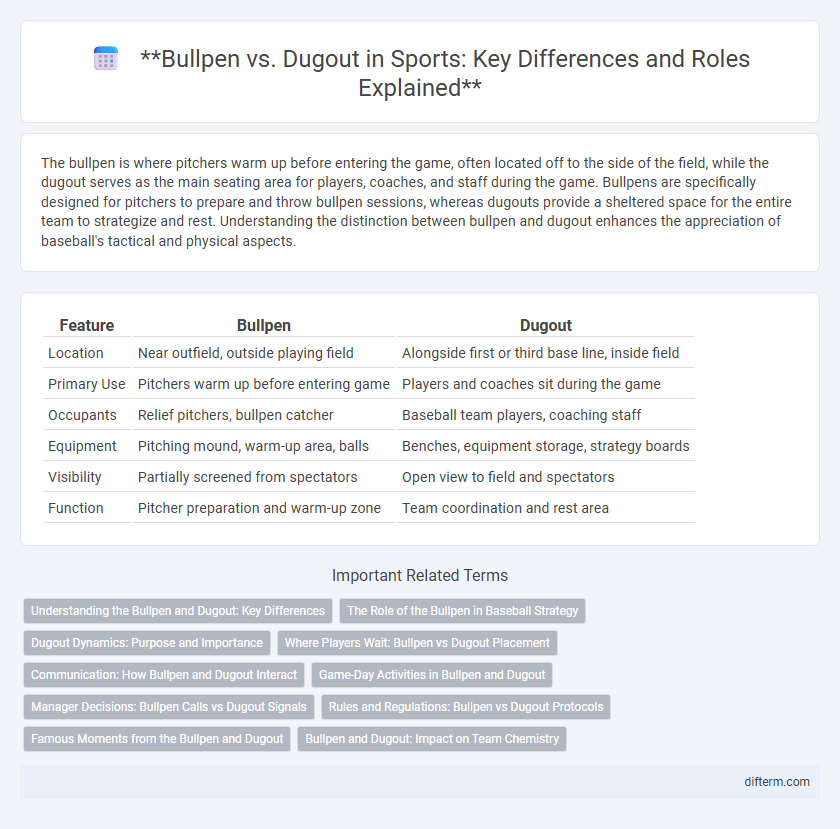The bullpen is where pitchers warm up before entering the game, often located off to the side of the field, while the dugout serves as the main seating area for players, coaches, and staff during the game. Bullpens are specifically designed for pitchers to prepare and throw bullpen sessions, whereas dugouts provide a sheltered space for the entire team to strategize and rest. Understanding the distinction between bullpen and dugout enhances the appreciation of baseball's tactical and physical aspects.
Table of Comparison
| Feature | Bullpen | Dugout |
|---|---|---|
| Location | Near outfield, outside playing field | Alongside first or third base line, inside field |
| Primary Use | Pitchers warm up before entering game | Players and coaches sit during the game |
| Occupants | Relief pitchers, bullpen catcher | Baseball team players, coaching staff |
| Equipment | Pitching mound, warm-up area, balls | Benches, equipment storage, strategy boards |
| Visibility | Partially screened from spectators | Open view to field and spectators |
| Function | Pitcher preparation and warm-up zone | Team coordination and rest area |
Understanding the Bullpen and Dugout: Key Differences
The bullpen is an area designated for relief pitchers to warm up before entering the game, located beyond the outfield fence or along the foul lines, while the dugout serves as the team's primary seating area during the game, positioned along the first and third baselines. Bullpen activity directly influences pitching changes and game strategy, whereas the dugout functions as a tactical hub where coaches and players coordinate plays and manage in-game decisions. Recognizing these distinct roles clarifies how baseball teams optimize player readiness and game flow through specialized spaces.
The Role of the Bullpen in Baseball Strategy
The bullpen is crucial in baseball strategy as it serves as the specialized group of relief pitchers ready to enter the game to maintain or regain control. Unlike the dugout, which houses the entire team and coaching staff during the game, the bullpen specifically focuses on managing pitching changes and adapting to situational challenges. Effective bullpen management can decisively influence the outcome by leveraging relief pitchers' skills to counter opposing batters and preserve leads.
Dugout Dynamics: Purpose and Importance
The dugout serves as the central hub for player strategy, communication, and team morale during a baseball game. It provides shelter and seating for players and coaches while acting as the strategic command center for in-game decisions. Effective dugout dynamics enhance team cohesion, focus, and the ability to respond quickly to evolving gameplay situations.
Where Players Wait: Bullpen vs Dugout Placement
The bullpen is typically located beyond the outfield fence or along the foul lines, providing pitchers a dedicated space to warm up before entering the game. The dugout is positioned in front of the stands along the first or third base line, serving as the primary area where players, coaches, and managers sit during the game. Understanding the spatial distinction between the bullpen and dugout enhances strategies related to player readiness and in-game communication.
Communication: How Bullpen and Dugout Interact
The bullpen and dugout communicate constantly through hand signals, radios, and visual cues to coordinate pitcher warm-ups and in-game strategy. Coaches in the dugout relay pitch selection and game adjustments to the bullpen to ensure seamless pitcher changes. This real-time interaction enhances team performance by preparing relievers efficiently while maintaining strategic control.
Game-Day Activities in Bullpen and Dugout
Pitchers in the bullpen focus on warming up with simulated pitches and stretching exercises to prepare for their entry into the game. Catchers and coaches strategize in the dugout, reviewing signs and discussing pitching sequences to optimize game performance. The dynamic environment of the dugout facilitates real-time decisions and player support, contrasting with the bullpen's primary function of physical readiness.
Manager Decisions: Bullpen Calls vs Dugout Signals
Manager decisions in sports hinge heavily on bullpen calls versus dugout signals, with bullpen coaches assessing pitcher readiness and reliever options based on real-time performance metrics and game context. Dugout signals, often conveyed through hand gestures or coded signs, communicate strategic adjustments directly from the manager to players, emphasizing lineup changes or defensive shifts. The effectiveness of these decisions relies on seamless coordination, situational awareness, and accurate interpretation of opponent tendencies.
Rules and Regulations: Bullpen vs Dugout Protocols
Bullpen protocols dictate designated areas for relief pitchers to warm up, ensuring they remain off the field until officially entering the game, while dugout regulations require all players to stay within designated team areas during play. MLB rules enforce strict communication guidelines in the bullpen to avoid game delays, whereas dugout conduct rules prohibit unauthorized personnel from accessing the field or interfering with play. Both areas operate under umpire supervision to maintain order and fairness, with penalties imposed for violations such as illegal warm-up pitches or unsportsmanlike behavior.
Famous Moments from the Bullpen and Dugout
The bullpen has been the backdrop for iconic pitching changes, such as Mariano Rivera's entrance in the 1998 ALCS, showcasing the emotional intensity of relief pitchers preparing to dominate. Legendary managers like Joe Torre have strategized in the dugout, orchestrating game-winning moves exemplified by the 1996 World Series. Moments from both locations capture the strategic heart of baseball, where split-second decisions create unforgettable sports history.
Bullpen and Dugout: Impact on Team Chemistry
The bullpen serves as the strategic hub for relief pitchers, fostering communication and coordination that directly influence in-game decisions and overall team morale. The dugout acts as the central gathering spot where players and coaches collaborate, share insights, and reinforce team unity during the game. Effective interaction between bullpen and dugout enhances team chemistry by aligning pitching strategy with player support, leading to stronger performance under pressure.
bullpen vs dugout Infographic

 difterm.com
difterm.com